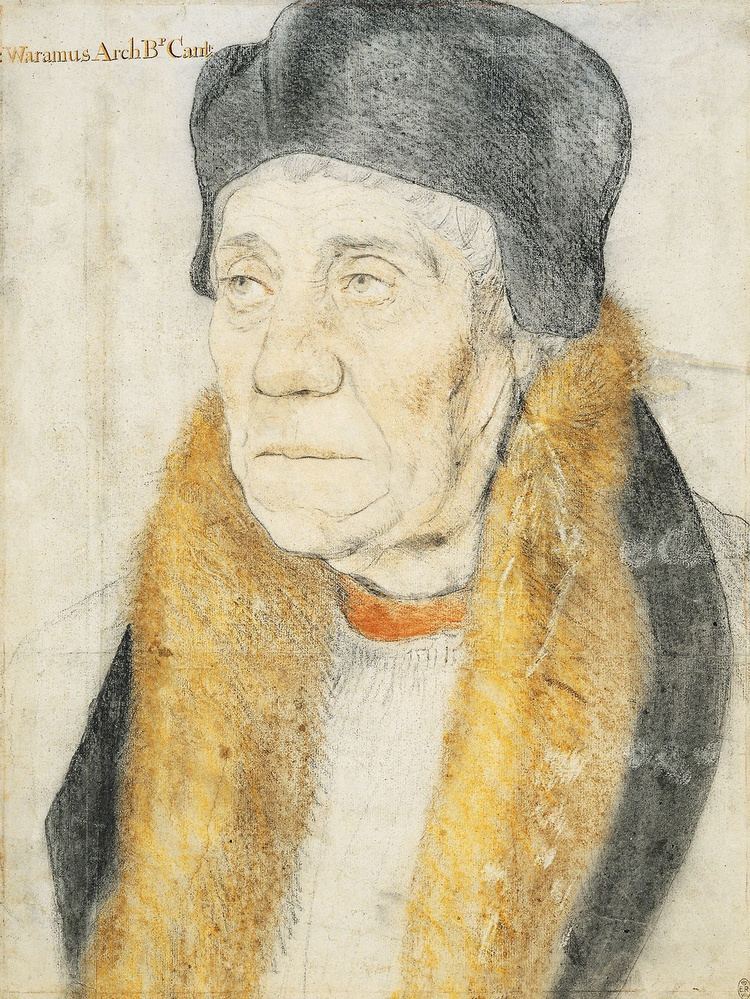Church Roman Catholic Term ended 22 August 1532 Predecessor Henry Deane | Name William Warham Appointed November 29, 1503 | |
 | ||
Died August 22, 1532, Hackington, United Kingdom Education | ||
Place of burial Kent, United Kingdom | ||
William Warham (c. 1450 – 22 August 1532) was the Archbishop of Canterbury from 1503 to his death.
Contents
Early life and education
Warham was the son of Robert Warham of Malshanger in Hampshire. He was educated at Winchester College and New College, Oxford.
Legal career
After graduating, Warham practised and taught law both in London and Oxford. His father was a tenant farmer, but his brother, Sir Hugh Warham, acquired an estate at Croydon, which passed to his daughter Agnes, who married Sir Anthony St Leger.
Bishopric
Later, Warham took holy orders, held two livings (Barley and Cottenham) and became Master of the Rolls in 1494. Henry VII found him a useful and clever diplomatist. He helped to arrange the marriage between Henry's son, Arthur, Prince of Wales, and Catherine of Aragon. He went to Scotland with Richard Foxe, then bishop of Durham, in 1497. He was partly responsible for several commercial and other treaties with Maximilian I, Holy Roman Emperor, also Count of Flanders and Regent Duke of Burgundy, on behalf of his son Philip IV of Burgundy.
Archbishopric
In 1502, he was consecrated Bishop of London and became Keeper of the Great Seal, but his tenure of both offices was short, as in 1504, he became Lord Chancellor and Archbishop of Canterbury. In 1506, he became Chancellor of Oxford University, a role he held until his death. In 1509, he married and then crowned Henry VIII and Catherine of Aragon.
On 28 September 1511, he made a visit to the hospital at Maison Dieu, Faversham.
As archbishop, Warham seems to have been somewhat arbitrary; for example, his actions led to a serious quarrel with Foxe, now Bishop of Winchester, and others in 1512. That made him gradually withdraw into the background after the coronation. He resigned the office of Lord Chancellor in 1515 and was succeeded by Thomas Wolsey, whom he had consecrated as bishop of Lincoln in the previous year. His resignation was possibly because of his dislike of Henry's foreign policy.
Warham was present at the Field of the Cloth of Gold in 1520 and assisted Wolsey as assessor during the secret inquiry into the validity of Henry's marriage with Catherine in 1527. Throughout the divorce proceedings, Warham's position was essentially that of an old and weary man. He was named as one of the counsellors to assist the queen, but, fearing to incur the king's displeasure and using his favourite phrase ira principis mors est ("the king's anger is death"), he gave her very little help and signed the letter to Pope Clement VII that urged the pope to assent to Henry's wish. Later, it was proposed that the archbishop himself should try the case, but the suggestion came to nothing.
Warham presided over the Convocation of 1531, when the clergy of the Province of Canterbury voted £100,000 to the king to avoid the penalties of praemunire and accepted Henry as supreme head of the church with the face-saving clause "so far as the Law of Christ allows".
In Warham's concluding years, however, the archbishop showed rather more independence. In February 1532, he protested against all acts concerning the church passed by the parliament that met in 1529, but that did not prevent the important proceedings which secured the complete submission of the church to the state later in the same year. Against this further compliance with Henry's wishes, Warham drew up a protest in which he likened the action of Henry VIII to that of Henry II and urged Magna Carta in defence of the liberties of the church. He attempted in vain to strike a compromise during the Submission of the Clergy.
Death and legacy
Having been munificent in his public and moderate in his private life, he died on a visit to his nephew, also William Warham. He was buried in the Martyrdom (north) transept of Canterbury Cathedral.
